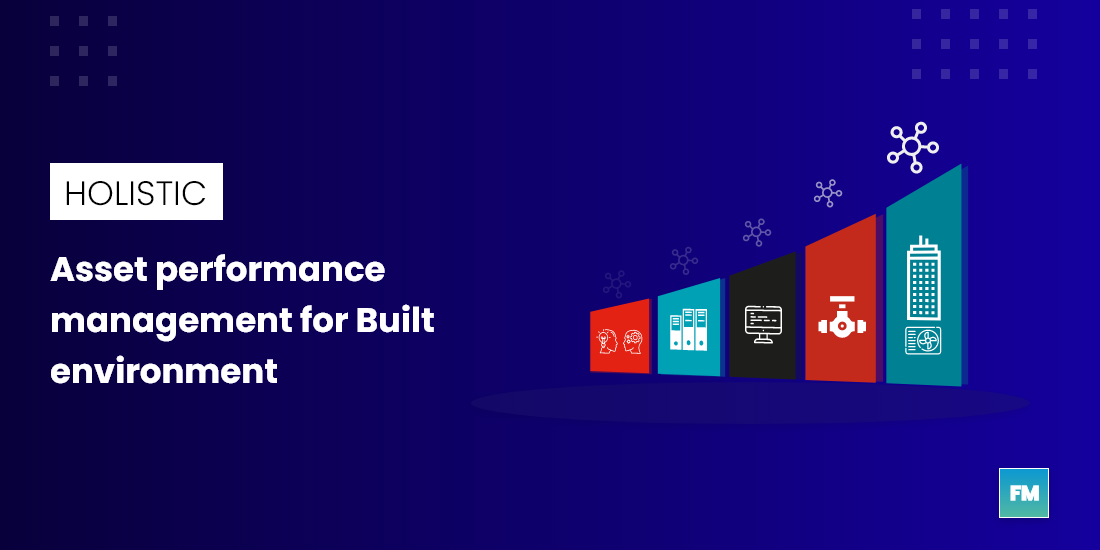In the past couple of years, asset performance management specifically in the built environment has seen unprecedented traction. Every leading facility management leader is talking about it everywhere and not just that, even started by making strategic initiatives and moves. In this blog, throwing a spotlight on this different perspective of APM leading to multiple definitions of “Holistic” Asset performance strategy.
Trying to cover as many definitions or angles to call APM strategy a holistic one or it’s simply everything that comes under the much-hyped word “holistic”
It all started with the mission to improve equipment or asset reliability. Unexpected downtime and sudden breakdown of the asset have cost dearly to FM teams not to mention the discomfort it has caused to tenants and end customers. Hence the movement started to improve the predictability of the asset operations. With IoT and smart communication technologies, it becomes easier to monitor every critical piece of equipment in the facility such as HVAC, elevators & lifts.
Then came the era of cloud computing and analytics making data processing even faster and cost-efficiency. Software as a service model changes the way facility management applications were sold and consumed in commercial real estate space. Mobile technologies came up as the icing on the cake. However, in this whole journey, there were a lot of technology trends, misconceptions, and biases that came in and affected the decision-making abilities of the facility manager, portfolio head, and property owners resulting in ad-hoc decisions of investigation in building technologies.
According to Andy Daecher, Deloitte’s report “asset performance management (APM) can do more than improve maintenance. By connecting systems across an enterprise, it can deliver insights to optimize operations, safety, and drive financial results”
This really broadens up our understanding of Asset performance management and relates it with other functions of FM (useful while coming up with ROI calculations) Deloitte’s report also noticed that ‘many firms still see APM as simply an advanced maintenance management system, leading to many siloed APM programs, both in insights derived and benefits delivered’
Aveva, a leading technology company shares a similar view on APM ‘True digital transformation requires upgrading APM from an asset-oriented approach to a system that holistically connects Engineering, Operations, and Performance. That’s APM 4.0’
It also emphasis on the process, people and system while building an APM strategy which can be elaborated in the following steps.
- Establish APM framework including Process, People, Systems, Data and Culture
- Review current state and set industry benchmarks to create goals
- Create a customized plan that prioritizes business goals
- Align plan to digital transformation business case (ROI)
- Align asset strategy by balancing cost, risk, and performance
- Add task insights to an asset data model and continue to refine your plan
Based on the discussions we have had with technology providers and CTOs form top FM firms we can say that an ideal APM strategy combines Information technology (IT) and operations technology (OT) to provide maintenance teams access to the data lake to create maintenance strategies, ways to move from planned preventive maintenance to a predictive one. While teams can advance in forecasting maintenance timing they can also look into life cycle assessment.
SAP’s intelligent asset performance management strategy does exactly the same. It believes in managing asset performance across asset life cycles to consistently monitor, review, and improve. SAP uses a six-step continuous process for asset strategy: Define, Identify, Analyze, Recommend, Implement and Verify. Which is an extensive mechanism to track every step from fault detection to corrective action.
In one of our Discussions with Derren Mccredaie, head of estates, Sodexo healthcare, mentioned that ‘asset reliability is the key here, as well as higher functionality of the asset and low vulnerability of the systems. when these three aspects meet with resiliency then you get a great holistic asset performance management strategy.’
Of course, energy management and life cycle monitoring is something that has to be there to identify and reduce the losses.
Once your team finalizes what they want to drive from a Holistic APM strategy, the next question comes up as to how to select the right vendor for the same? Well in one of our earlier articles we have described how to plan for APM trials that cover setting a hypothesis, selecting an ideal site, and choosing the right vendor/s for the trial.
We hope this article has given you a clear understanding of a holistic Asset performance maintenance strategy that you can use to improve operational efficiency at your facility.

Leave a Reply